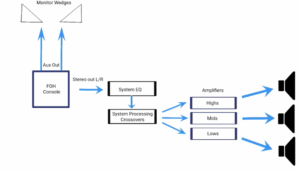Understanding Your PA Needs
Choosing the correct PA system for your event is an important but sometimes overwhelming step with the multitude of options available. Here we will go into detail about what the main components of a PA system are, how they operate, and how you can determine what will be best for you and your next setup!

It is important to have a good idea of what kind of equipment you may need from your audio-visual team when planning your event. The principle tool will be the right PA system to ensure communication is clear and concise with your audience. This guide will help you better understand the basics of PA systems so that you can have a good idea of what you need from your audiovisual partner!
What is a PA System?
What is a PA System?
A PA System stands for “Public Address System” and it is a device meant to amplify the human voice. Any system of one or more speakers designed to replicate and amplify audio to a group of people qualifies as a PA system. In its simplest form it is made up of a microphone, mixer, and loudspeakers.
Speakers
Speakers
The most important components of any PA system are the speakers. While they come in many different shapes and sizes, there are three primary styles of speakers: mains, subwoofers, and stage monitors.
Main speakers create the bulk of the PA’s sound and are most often placed on speaker stands or mounted on top of the subwoofers whereas subwoofers produce much lower frequencies than the mains and therefore give a “filling out” effect to the sound that the ear will end up hearing. Because of this, a crossover unit to separate the sound between the subwoofers and mains is usually deployed. Stage monitors are positioned near the performer on the ground and tilted at an angle towards them so that they can hear themselves.
Amplifiers
Amplifiers
An amplifier is the device that converts low voltage electronic audio signals from your source equipment into a signal with enough gain to be used to power the speakers and are either active or passive.
Active speakers have an internal amplifier built in, making it easy to use with a simple plug and play set up and are more budget friendly for smaller events and individual use.
Passive speakers, on the other hand, do not have an internal amplifier and rely on an external source which means more hardware for your setup. Because of the extra equipment, passive speakers are better for larger events and budgets.
Mixing Consoles
Mixing Consoles
Mixing Consoles are another important part of a PA system with endless options for size, style, and set up. They have a set number of channels each responsible for combining sounds, routing the signal, and changing the dynamics of many contrasting audio signals. A mixer can provide phantom power for capacitor microphones, pan control on each of the channels, and monitor the mixes for the stage monitors.
Learn more about what a sound board does HERE.
Cabling
Cabling
Various cabling is required to connect the components of a PA system and transmit the audio signal. Mixers and amplifiers usually have main outputs and inputs of both XLR and TRs, but some amplifiers can have a form of RCA outputs called banana cabling.
Effects
Effects
Another common component in PA systems is Effects. Many modern mixers will have onboard effects, but you can still find PA systems paired with outboard effects which are stand-alone units. The most common effects are reverb, compression, delay, gates, and equalizers.
Sound Sources
Sound Sources
The most common sound source is the sound for a microphone which has a variety of uses, placements, and forms. PA systems also excel at reproducing already recorded music, being able to play it by feeding the sound through one or more channels on the mixer board.
Signal Flow
Signal Flow
Signal Flow is the order of operations the sound will go through in the PA system. A typical signal flow is depicted in the figure below.

Operation
Operation
As with most modern pieces of technology, operating even the simplest PA systems can sometimes be frustrating. Most small-scale events need little to no tweaking on the settings of the mixer after a soundcheck is performed while larger scale productions require a skilled engineer present to mix the sound for the duration of the event.




